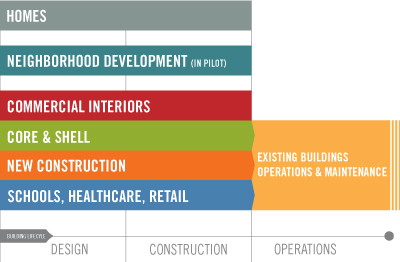What is LEED®?
The Leadership in Energy and Environmental Design (LEED) Green Building Rating System™ encourages and accelerates global adoption of sustainable green building and development practices through the creation and implementation of universally understood and accepted tools and performance criteria.

LEED is a third-party certification program and the nationally accepted benchmark for the design, construction and operation of high performance green buildings. LEED gives building owners and operators the tools they need to have an immediate and measurable impact on their buildings’ performance. LEED promotes a whole-building approach to sustainability by recognizing performance in five key areas of human and environmental health: sustainable site development, water savings, energy efficiency, materials selection and indoor environmental quality.
Who uses LEED?
Architects, real estate professionals, facility managers, engineers, interior designers, landscape architects, construction managers, lenders and government officials all use LEED to help transform the built environment to sustainability. State and local governments across the country are adopting LEED for public-owned and public-funded buildings; there are LEED initiatives in federal agencies, including the Departments of Defense, Agriculture, Energy, and State; and LEED projects are in progress in 41 different countries, including Canada, Brazil, Mexico and India.
How is LEED Developed?
LEED Rating Systems are developed through an open, consensus-based process led by LEED committees. Each volunteer committee is composed of a diverse group of practitioners and experts representing a cross-section of the building and construction industry. The key elements of USGBC's consensus process include a balanced and transparent committee structure, technical advisory groups that ensure scientific consistency and rigor, opportunities for stakeholder comment and review, member ballot of new rating systems, and a fair and open appeals process.
LEED Rating Systems
- New Construction
- LEED for New Construction and Major Renovations is designed to guide and distinguish high-performance commercial and institutional projects.
- Existing Buildings: Operations & Maintenance
- LEED for Existing Buildings: Operations & Maintenance provides a benchmark for building owners and operators to measure operations, improvements and maintenance.
- Commercial Interiors
- LEED for Commercial Interiors is a benchmark for the tenant improvement market that gives the power to make sustainable choices to tenants and designers.
- Core & Shell
- LEED for Core & Shell aids designers, builders, developers and new building owners in implementing sustainable design for new core and shell construction.
- Schools
- LEED for Schools recognizes the unique nature of the design and construction of K-12 schools and addresses the specific needs of school spaces.
- Retail
- LEED for Retail recognizes the unique nature of retail design and construction projects and addresses the specific needs of retail spaces.
- Healthcare
- LEED for Healthcare promotes sustainable planning, design and construction for high-performance healthcare facilities.
- Homes
- LEED for Homes promotes the design and construction of high-performance green homes.
- Neighborhood Development
- LEED for Neighborhood Development integrates the principles of smart growth, urbanism and green building into the first national program for neighborhood design.
- LEED Rating System Drafts
- Review and comment on proposed final drafts of new and updated LEED Rating Systems.
- LEED Frequently Asked Questions
- This is a great resource for first time LEED users and experienced project team members alike.